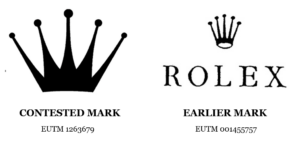In a recent decision (T-726/21), the General Court (“GC”) confirmed that Rolex SA (“Rolex”) could not prevent the Danish fashion brand “Junk de Luxe” (owned by the company PWT A/S) from registering a trademark for their logo depicting a crown.

The contested sign was among others filed for goods covering clothing, footwear and headgear in class 25, whereas Rolex’ earlier trademark was registered for watches in class 14.
The question was whether Rolex could demonstrate a sufficient reputation in EU, and that the use of the contested trademark would, without due cause, take unfair advantage of, or be detrimental to, the distinctive character or the repute of the earlier trademark.
The Opposition Division upheld the opposition on the basis of Article 8(5) EUTMR concluding that that the contested trademark would take unfair advantage of the distinctive character or the repute of the composite ROLEX trademark. Consequently, the Opposition Division rejected the contested mark from registration for all of the applied goods and services in classes 3, 9, 18, 25 and 35. PWT A/S appealed this decision, but only in relation to the goods in class 25, namely clothing, footwear and headgear.
The Board of Appeal upheld the appeal. It found that there was no likelihood of confusion based on Article 8(1)(b) EUTMR and that even though the composite ROLEX trademark (consisting of both the crown and the word ROLEX) has a reputation for wrist watches, the relevant public would not make a link between the marks. Consequently, no risk of injury to the reputation of the earlier composite mark was established.
Rolex brought the decision of the Board of Appeal before the GC.
Likelihood of confusion
The Board of Appeal had found that clothing, footwear, and headgear covered by the contested mark were dissimilar to the jewelry and watches covered by the earlier marks due to the dissimilar characteristics and intended uses. The former being used for dressing the body while the latter is meant for personal adornment. Additionally, it was found that these goods were not distributed through the same channels and were not in competition with or complementary to each other.
Rolex criticized the Board of Appeal for comparing the goods at issue without having taken account of their usual origin or the usual market practice followed in relation to them. Additionally, Rolex submitted that the goods belong to linked market segments and that their purchase may be motivated by the search for an aesthetic complementarity.
The GC rejected all of the arguments put forward by Rolex and found that there was no likelihood of confusion between the two marks within the meaning of art. 8(1)(b) EUTMR.
Infringement of the reputed trademark
In connection with the reputation of the ROLEX brand, it had been established that the composite mark, consisting of both the crown and the word ROLEX, had acquired a reputation within the European Union. In connection with the similarity between this mark and the applied mark, the Board of Appeal had concluded that at most the marks were visually similar to a very low degree, and that the conceptual similarity resulting from the common presence of a crown had a very limited impact. It inferred from this that the relevant public would not make a link between those marks, with the result that no risk of injury to the reputation of the earlier composite mark was established.
The GC did not comment on the Board of Appeal’s decision in terms of the proximity of the goods in question and the establishment of a link in the minds of the consumers (thereby accepting the reasoning of the Board of Appeal in this respect). The GC focused their reasoning on the requirement regarding the proof that the use of the mark applied for would take unfair advantage of the distinctive character or the repute of the earlier mark, or that it would be detrimental to that distinctive character or that repute.
In this respect the GC concluded that Rolex had not proven that there was a serious risk that an injury would occur to their mark in the future. In its assessment the GC focused on the burden of proof and stated that Rolex had merely referenced certain pages of its observations before the Opposition Division and had only argued in general terms in connection with the existence of the injury to the reputed brand. Such argumentation was not found sufficient by the GC.
Consequently, Rolex had failed to prove that the use of the contested trademark would take unfair advantage of, or be detrimental to, the distinctive character or the reputation of the earlier trademark. The action was therefore dismissed in its entirety by the GC.
Comment
The decision is particularly interesting in relation to the question of the proximity of the goods in question in light of the assessment of the scope of protection for a reputed brand.
Although case law have previously stated that there is no similarity between clothing and for instance jewelry and watches in terms of the assessment of likelihood of confusion, it does appear to be a rather strict approach taken by the GC in the present matter as we are dealing with a reputed luxury brand like ROLEX and since fashion items, when it comes to luxury and reputed brands, may very likely in the eyes of the consumers cover various kind of products (from different categories) such as clothing, jewelry and watches. One must assume that the weak character of the colliding crown element has also played a major role in finding that no infringement occurred.
In addition, the decision underlines that it is not enough to merely refer to the reputation of a brand and in general terms state that there is a risk of injury. This risk has to be substantiated with strong arguments and evidence.
_____________________________
To make sure you do not miss out on regular updates from the Kluwer Trademark Blog, please subscribe here.


